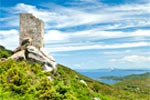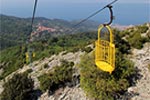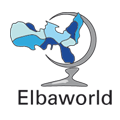History of Elba Island
Elba Island was inhabited by an ancient Ligurian populations, who
started mining activities since the early Iron Age. However,
excavations and findings proved human presence from the
Paleolithic. Around the tenth century
BC, Greeks from Phocaea settled in the Island, attracted
by the abundance of iron ore, which melted on site using
rudimentary processing methods. From the greek
"aithalos" (smoke) the Island took its first
name (Aethana or Aethalia), for the thick smoke that were coming
out of the countless furnaces, which after extensive use of wood,
led to the destruction and depletion of forests.
When the Etruscans (sixth century) and the Greeks of
Syracuse (fourth century) took over, the Iron
manufacturing was moved to the mainland, in the area of
Populonia, where it continued in Roman times until the early
centuries of the Empire. With the Roman domination Aethalia took
the name of Ilva, for the primacy of the Ilvates (the race from
the Ligurian coast) who were able to reach great economic and
commercial growth. Their wealth lasted until a law forbade
turning on furnaces for the excessive depletion of both coastal
and Elba forests. In fact, Rome was expanding its Empire in
Europe and Asia taking possession of rich iron mines where
extraction and processing systems were cheaper than Elba; then
begun its rapid decline.
At the fall of the Roman Empire, Elba could not escape the
Lombard invasion and was ruled by a duke based in Lucca. In a
passage of the Dialogues of Gregory the Great (second half of the
eleventh century), appears for the first time
the name of Elba instead of Ilva.
At the end of Lombard rule, Elba, which at the time of Sextus
Pompey had been an impregnable fortress and naval base, was
exposed to the raids of Greek, Norman and Saracen pirates who
devastated the island several times.
After being papal patrimony, in the tenth century Elba passed
into the political sphere of Pisa.
In the eleventh century Elba was invaded by the forces of
Al-Mujahid, who, after having conquered the
Balearics and Sardinia (1015), held the island until the defeat
of Luni versus the combined fleets of Pisa and Genoa. In order to
defend the island against the threat of Saracen raids, Pisa
fortified some places on the island, especially
Marciana, Rio and
Capoliveri. Meanwhile were also rebuilt the
fortresses of Luceri and Volterraio, where once stood an Etruscan
acropolis.
The Pisan rule in Elba remained always under risk, due to the
continuous attempts of Genoa to take possession of this strategic
island of the Tyrrhenian Sea. After the battle of Meloria,
disastrous for Pisa, the Genoese took possession of Elba, but
after only two years (1292), it was back to Pisa. After ups and
downs, that saw the island involved even in the wars with
Florence, in 1399 Elba became part of the state of Piombino,
Suvereto, Buriano, Scarlino, Vignale, Populonia, Elba, Pianosa
and Montecristo.
The lords of Piombino didn't have easy times to defend their rule
against frequent barbarian invasions and repeated threat from
Siena to Florence. Meanwhile Elba continued to be fought over by
Genoa, which in 1441 tried to conquer it, as well as Alfonso of
Aragon in 1448. During the wars of domination fought between
France and Spain, the State of Piombino, despite its declared
neutrality, was unable to avoid being involved. Elba was in turn
used by French forces and Spanish ones as a naval base. In 1501,
Cesare Borgia, known as Valentino and son of Pope Alexander VI,
forced into exile Giacomo IV Appiano, who could regain possession
of his State only in 1503, after the death of the pope.
In order to strengthen his power, Giacomo IV allied with
Ferdinand the Catholic, who conferred him the title of Captain of
the Spanish forces in the Kingdom of Naples. As a result of this
alliance Giacomo IV received a contingent of troops and a fleet
to defend his state. In 1509, he ensured also
the protection from Maximilian I of Habsburg, who elevated the
Lordship of Piombino to Princedom declaring it Imperial Fiefdom;
this recognition was later ratified by Rudolf II too.
During the reign of Giacomo V, coasts and islands of Tuscany
underwent many barbarian raids, especially by Khair ad-Din, known
as Barbarossa, who had established his lair in the Isle of
Palmaiola.
Elba was repeatedly ransacked and many of its inhabitants were
deported as slaves, some of whom were later freed by Charles V,
when, in retaliation, he attacked and destroyed Tunis.
However, the danger of new raids remained and to thwart the
constant Saracen threat, in 1548,
Charles V entrusted the defense to
Cosimo I de' Medici, Duke of
Tuscany, investing him with the fief of Piombino. This
investiture, however, was immediately revoked the following year,
following the protests of the Duchess in charge Elena Appiano,
mother of Giacomo VI, and the Genoese. Anyway
the geopolitical situation of Elba was already changed: the
Medici family hold the territory where later would rise
Portoferraio and the Appiani got the rest of the
island.
On the ruins of the ancient villages of Fabricia
and Ferraia, was built a fortress in honor of
Cosimo, that should have been called Cosmopolis, but that in the
end took the less bombastic name of Portoferraio. The
impenetrable defence consists of three forts bounded by solid and
powerful walls.
In 1553, Medici's defences proved to be very
efficient when the Turks of Dragut, encouraged
by France, attacked the island and devastated the lands of the
Appiano family, while Portoferraio remained undamaged.
As Elba was a good base for fleets, under the vice King of
Naples, Juan Alfonso Primentel Herrera, the Spanish occupied
Longone and established a permanent garrison; so, since 1603, the
island became tripartite between the Grand Duke of Tuscany, the
House of Appiani and Spain.
This policy aspect was preserved until 1738,
when the Treaty of Vienna (at the end of the War of Polish
Succession) assigned the entire island to the Grand Dukes of
Lorraine, as the House of Medici extinguished.
Already in 1734, with the extinction of the
House of Appiano, the principality of Piombino was sold by the
Emperor to Niccolò Ludovisi, husband of Polissena Appiano. In
1735 Longone and the State of Presadi became
part of the Bourbon Kingdom of Naples.
After the transfer of Corsica under the French rule (1768),
England put pressure on Leopold II to acquire Elba, but the
initiative was rejected by the Bourbons and France.
In 1796, after the occupation of Livorno by the Republican
troops, the British landed on the Island of Elba with the pretext
of protecting the 4000 French royalists, who two years earlier
had found asylum in Portoferraio. Because of the continuous
warfare between French, English, Bourbon and Lorraine armies, the
situation became highly unstable and ended only in
1802, when the Peace of Amiens annexed Elba to
France.
From that time, the Island followed the French administrative
system and in its district were included also the Islands of
Capraia, Pianosa, Montecristo and Palombaia. Overall the French
domination advantaged the Island, which saw improved its road
network, activated its trade and had a significant increase of
its economy.
However, the new tax system and the establishment of the land tax
produced severe discrepancies and discontent, particularly among
landowners and generally among all those who derived no benefit
from the maritime trade.
In the Capoliveri area, especially, the aversion towards the
French broke out in frequent riots that were bloodily
suppressed.
With the Treaty of Fontainebleau (11 April
1814), Elba, together with Pianosa and Palmaiola, formed
an independent kingdom assigned to Napoleon, who
held the island from the 3rdof May 1814 to the 26thof
February 1815. After the brief reign of Napoleon, the
Island returned to the Grand Duchy of Tuscany and then to
the Kingdom of Italy in 1860.

The first settlements
Elba was inhabited since the Paleolithic Age for its rich deposits of iron and granite minerals .

The Etruscans on Elba
Elba was inhabited by Etruscan since the end of the Iron Age (ninth - eighth century BC) and made the fortune of this great civilization

The Romans on Elba
After the Etruscan decline, Romans inherited the iron industry of Elba and also exploited the granite.

The Christianity on Elba
The Christian history, has left many evidences on Elba and other islands of the Tuscan Archipelago.

The rule of Pisa
The Maritime Republic of Pisa continued exploiting the iron mines and granite quarries from the sixth until the twelfth century AD.

The family Medici in Elba
Portoferraio was subject to major changes in the times of the
Grand Duchy until its transformation by the will of Cosimo I de
'Medici.

The Spaniards in Elba
The Spaniards ruled the Eastern Elba for one and a half century fortifying Porto Longone with the construction of the Fort San Giacomo

The rule of the Appiani
The Appiani family and its dominion over Elba at the end of the fourteenth century.

French and pre Napoleonic period
In the pre-Napoleonic period Portoferraio and all Elba Island is ruled by France.

Napoleon in Elba
The arrival of Napoleon in Elba, his lifestyle and his Villas become today Museum of Napoleonic Residences
Elbaworld suggests

What to visit
Discover places and attractions nearby.

Recommended excursions
Discover incredibly beautiful excursions on Elba Island.













